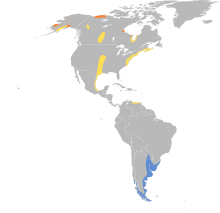|
Hudsonian godwit
The Hudsonian godwit (Limosa haemastica) is a large shorebird in the sandpiper family, Scolopacidae. It is a long distance migratory species that breeds at remote sites in northern Canada and winters in southern South America. The genus name Limosa is from Latin and means "muddy", from limus, "mud". The specific haemastica is from Ancient Greek and means "bloody".The English term "godwit" is believed to imitate the bird's call. TaxonomyThe Hudsonian godwit was formally described in 1758 by the Swedish naturalist Carl Linnaeus in the tenth edition of his Systema Naturae. He placed it in the genus Scolopax and coined the binomial name Scolopax haemastica.[2] Linnaeus based his entry on the "red-breasted godwit" that had been described and illustrated in 1750 by the English naturalist George Edwards in the third volume of his A Natural History of Uncommon Birds. Edwards had obtained a specimen that had been collected in the Hudson Bay region of Canada by James Isham, an employee of the Hudson's Bay Company. [3] Linnaeus specified the type locality as North America but this is restricted to the Hudson Bay following Edwards.[4] The Hudsonian godwit is now one of four species placed in the genus Limosa that was introduced in 1760 by French zoologist Mathurin Jacques Brisson. The species is considered to be monotypic: no subspecies are recognised.[5] The genus name Limosa is from Latin and means "muddy", from limus, "mud". The specific epithet haemastica is from Ancient Greek haimatikos meaning "bloody".[6] The English name "godwit" was first recorded in about 1416–17 and is believed to imitate the bird's call.[7] DescriptionAdults have long dark legs and a long pink bill with a slight upward curve and dark at the tip. The upper parts are mottled brown and the underparts are chestnut. The tail is black and the rump is white. They show black wing linings in flight. The legs and feet are bluish-grey.[8]
Distribution and habitatThey migrate to South America and the Caribbean. These birds gather at James Bay before fall migration. In good weather, many birds make the trip south without stopping. They are vagrants to Europe, Australia, and South Africa. They can perhaps be most easily seen in migration on the east coast of North America where they can be plentiful in migration in late July through early August. Behaviour and ecologyBreedingTheir breeding habitat is the far north near the tree line in northwestern Canada and Alaska, also on the shores of Hudson Bay. They nest on the ground, in a well-concealed location in a marshy area. The female usually lays 4 olive-buff eggs marked with darker splotches. Incubation period is 22 days.[8] Both parents look after the young birds, who find their own food and are able to fly within a month of hatching.[10] Food and feedingThese birds forage by probing in shallow water. They eat invertebrates and plant material.[10] StatusThe species is classified as of Vulnerable by the International Union for Conservation of Nature.[1] References
External linksWikimedia Commons has media related to Limosa haemastica. Wikispecies has information related to Limosa haemastica.
|
||||||||||||||||||||||||||||||||||||||||||||||||||||||||||



